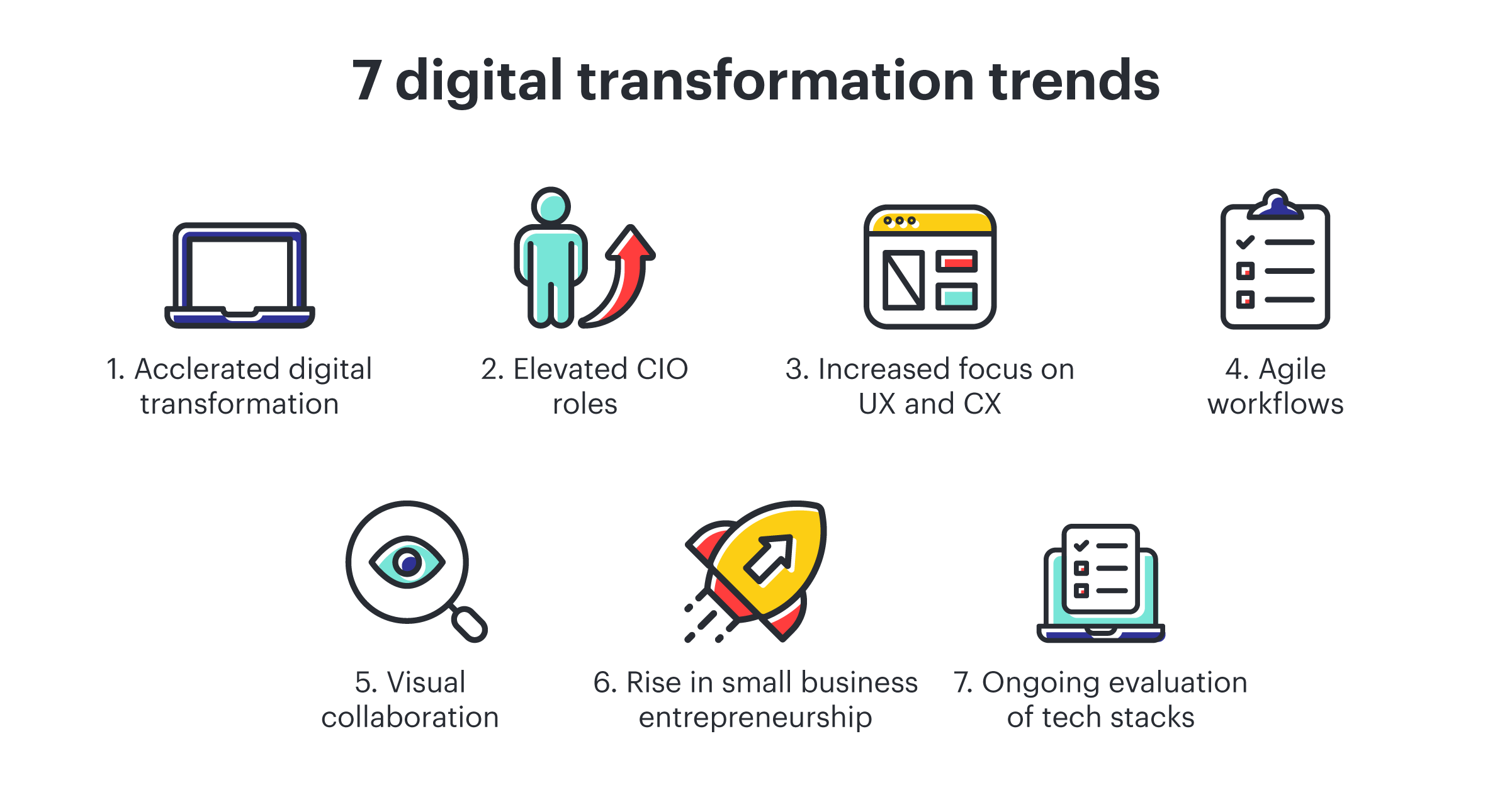
Digital transformation trends for the Next Normal
Reading time: about 6 min
Topics:
Some events act as change accelerators. The events of September 11 accelerated the shift toward increased surveillance. World War II accelerated the middle class and women in the workplace. The Great Depression accelerated centralized banking and social welfare programs.
Those are significant, culture-shifting events, and we've collectively experienced a similar shift due to the COVID-19 pandemic. Aside from essential workers, most of us saw our lives relegated indoors overnight. Workplaces, too, had to shift to fully remote operations with next to no notice.
The need for digital transformation was already underway—the pandemic put it into overdrive. And for many businesses, the choice was stark and clear: Go digital or go dark.
Now, the vast majority of interactions with coworkers, customers, and employees take place virtually. The companies that survived and thrived during this shift had either already embarked on a digital transformation journey or found new ways to stay agile and adapt to ever-changing conditions.
Let's start by looking at how digital transformation has become even more essential during the pandemic.
How digital transformation has changed—and become even more essential—during the pandemic
In recent years, digital transformation conversations have centered around more significant business process shifts—think cloud data storage, Internet of Things, tech stacks, AI, ML, and more.
During the pandemic, digital transformation took on a much more practical bent.
Never before had companies been faced with such an abrupt change in consumer behavior. While already widely available, videoconferencing capabilities necessarily increased their functionality and bandwidth capabilities to meet the needs of a nearly fully remote workforce.
Companies that relied heavily on in-person experiences, like restaurants, brick-and-mortar shops, and movie theaters, sprang into action to find ways to keep customers engaged and income flowing. Curbside pick-up and online ordering became daily norms, not luxuries. Digital transformation jumped from our laptops to our TVs as streaming services increased their offerings for quarantined viewers. The list goes on and on.
Essentially, digital transformation expanded into the essential parts of everyday life. Of course, it's also changing how companies, large and small, from mom and pop stores to enterprise organizations, work and do business. Digital transformation is imperative to survival, and digital laggards are running out of time to invest in post-pandemic digital realities.
Emerging digital transformation trends for the Next Normal
Here are some of the implications of digital transformation as we move beyond adapting to the New Normal and shift to preparing for the Next Normal.

Accelerated digital transformation
When local government mandates required many businesses and office spaces to close their doors, the impact was swift and immediate. Many of those in the hospitality or non-essential service industry lost their jobs entirely. Other organizations were forced to find a way to move all their employees to remote or VPN environments overnight.
Consumer behavior also shifted dramatically as people were relegated to their homes and relied on delivery services or pick-up options to get their everyday essentials (we all remember the empty toilet paper shelves). However, crisis breeds ingenuity. According to recent McKinsey research, respondents reported their companies adopted digital changes 20-25 times faster than expected. The same report showed that three out of four Americans tried a new shopping behavior during the pandemic.
The elevated role of the CIO
The importance of the CIO's role was already on the rise in the digital age, but the pandemic supercharged its significance. The CIO has long been tasked with running the IT department, evaluating and streamlining tech investments, and tying both back to operational efficiency and revenue. In a post-pandemic era, IT's role will continue to expand to help organizations quickly adopt digital products, stay agile and adaptive, and drive rapid change.
Increased focus on user experience (UX) and customer experience (CX)
In February 2020, just before the COVID pandemic took over our timelines and our lives, a Gartner survey found that 90% of companies had appointed a chief experience officer or similar CX role in their organization. Like the CIO, the CXO role also elevated in response to the pandemic as companies vied for customer attention across increasingly digital channels of communication.
The pandemic placed huge demands for innovation on UX and CX teams, from contactless customer service and delivery to QR codes to virtual events and augmented experiences. These heightened expectations for the customer experience will continue post-pandemic.
Agile workflows and continuous deployment
Speed and innovation drive success and both have become key indicators of organizational health in the COVID economy. Agile workflows and continuous deployment ensure that organizations can quickly pivot, adapt, respond to and learn from changing market conditions and customer demands.
The Agile framework gives companies the ability to deliver significant value without experiencing a breakdown in processes, making companies more responsive in a crisis but also more able to capitalize on opportunities.
Visual communication tools to enable remote collaboration
Another story in acceleration: The shift to remote work was already in motion before the COVID pandemic hit and from 2010-2020 the number of remote and work-from-home employees grew 115%.
According to Upwork's recent Future of Workforce Pulse report, 1 in 4 Americans will be working remotely in 2021. The report also reveals that 36.2 million Americans will be working remotely by 2025. While some organizations vow to bring employees back to physical offices in some capacity, new ways of working, including distributed workforces, are expected to stick.
Visual communication tools are effective collaboration tools for any work setup, but they're especially valuable when employees are scattered across the globe. Why? Visual communication tools like digital whiteboards, process maps, and Kanban charts can clearly communicate updates and priorities in a way that's easy to understand and refer back to later.
When used with video conferencing and messaging tools, these tools can also mimic the in-office collaboration lost to remote work and help employees stay engaged and connected.
A rise in small business entrepreneurship
Despite the economic hardships caused by the pandemic, there's also been a flood of new small businesses in its ongoing aftermath. McKinsey reports that in the third quarter of 2020 alone, more than 1.5 million people applied to register a new business in the United States—nearly double the figure for the same period in 2019. The European Union saw similar increases.
Spring (and ongoing) cleaning of tech stacks
Accelerated digital transformation has given many of us a crash course in innovation, but it hasn't always been a seamless process. Clunky rollouts are inevitable when scrambling to adapt to and adopt new technologies. Building on the CIO's elevated role, organizations will also need to focus on continually evaluating the quick investments made in response to the pandemic.
Now that the immediate crisis is behind us, organizations can shift their focus to optimizing the investments made so far, or ditching the ones that aren't working for them. This evaluation doesn't need to happen just once a year. Agility is key, and businesses that can adopt, adapt, and pivot quickly will continue to see success in a fast-changing post-pandemic economy.
If the pandemic has shown us anything, it's that necessity drives innovation, and the organizations that have found ways to adapt and adopt new technologies amid chaos have not only survived but thrived. Adopting digital capabilities is critical to business continuity in a post-pandemic world and in the Next Normal.

Learn how to pick the right tools for your modern technology stack.
Watch the webinarAbout Lucid
Lucid Software is the leader in visual collaboration and work acceleration, helping teams see and build the future by turning ideas into reality. Its products include the Lucid Visual Collaboration Suite (Lucidchart and Lucidspark) and airfocus. The Lucid Visual Collaboration Suite, combined with powerful accelerators for business agility, cloud, and process transformation, empowers organizations to streamline work, foster alignment, and drive business transformation at scale. airfocus, an AI-powered product management and roadmapping platform, extends these capabilities by helping teams prioritize work, define product strategy, and align execution with business goals. The most used work acceleration platform by the Fortune 500, Lucid's solutions are trusted by more than 100 million users across enterprises worldwide, including Google, GE, and NBC Universal. Lucid partners with leaders such as Google, Atlassian, and Microsoft, and has received numerous awards for its products, growth, and workplace culture.
Related articles
The role of virtual collaboration in digital transformation
Let's look at why virtual collaboration is vital to a company's success, why it should be one of the main focuses of a digital transformation, and what kind of collaborative technology can help companies accomplish digital transformation.
Collaboration technology guide: How to build a tech stack that accelerates work
Evaluating collaboration technology? Explore examples and get tips for choosing workplace collaboration tools that support your business goals.
What is stalling your digital transformation?
Let’s dive in and discuss a digital transformation strategy that continuously adapts to market changes and can adopt new technology.
4 reasons your agile transformation strategy is falling short
Leading an agile transformation is no easy feat—and many fall short. What's holding organizations back? In this blog, we'll explore four common challenges.
